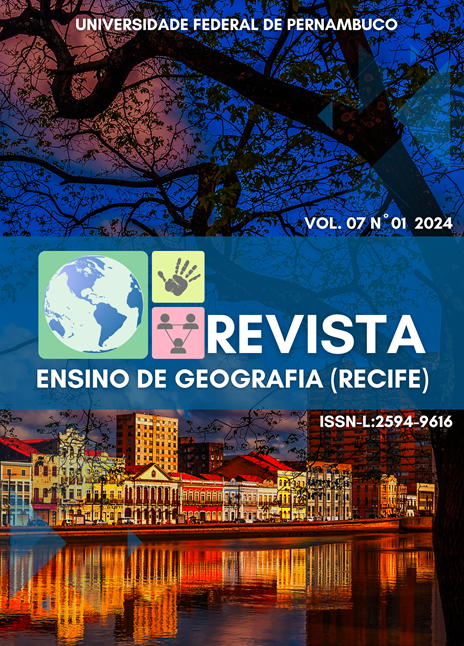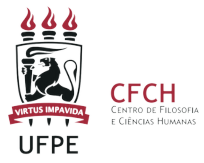Teaching geomorphology in geography graduation - reflections from the field class held at pico do papagaio, municipality of Triunfo/PE
DOI:
https://doi.org/10.51359/2594-9616.2024.259618Keywords:
field trip, Geography teaching, GeomorphologyAbstract
The present article approaches the observations of the field trip during the month of August 2022, as a requirement of the course of Domains of Brazilian Landscapes, of the Geography degree at the Regional University of Cariri (URCA). The route followed the Crato/CE – Triunfo/PE transect, reaching the highest point in the state of Pernambuco, at the Pico do Papagaio. In this respect as it is a key point for observing the landscape, the objective was to analyze the geomorphological aspects of Pico do Papagaio, as well as their interrelationship with the geological structure, climatic conditions, types of vegetation, soil classes and use and occupation forms, to understand the modeling and structuring of the landscape. In the methodological stages, followed by the bibliographic survey, the construction of a field notebook, characterization and cartographic production. After carrying out the field trip, aspects of the morphostructural and morpho-sculptural processes related to the evolution and dynamics of the relief were noted, as well as realizing that the field trip made learning pleasurable and less abstract. In this way, the field class contributed to understanding and visualizing the structure of the landscape.
References
ALVES, L. E. R., GOMES, H. B., DOS SANTOS, M. N., OCRÉCIO, T. C. M., DONASCIMENTO, G. C., & PEIXOTO, I. C. Métodos para obtenção e análise do albedo de superfície e IVDN, para o município de Triunfo-PE. 3° GeoAlagoas – Simpósio sobre as geotecnologias e geoinformação no Estado de Alagoas (2015) - ISBN 978-85-69709-00-8, Maceió/Alagoas, 8p.
ARAÚJO FILHO, J. C.; BURGOS, N.; LOPES, O. F.; SILVA, F. H. B. B.; MEDEIROS, L. A. R.; MELO FILHO, H. F. R.; PARAHYBA, R. B. V.; CAVALCANTI, A. C.; OLIVEIRA NETO, M. B.; SILVA, F. B. R.; LEITE, A. P.; SANTOS, J. C. P.; SOUSA NETO, N. C.; SILVA, A. B.; LUZ, L. R. Q. P.; LIMA, P. C.; REIS, R. M. G. & BARROS, A. H. C. Levantamento de reconhecimento de baixa e média intensidade dos solos do Estado de Pernambuco. Rio de Janeiro: Embrapa Solos, 2000. 378p. (Embrapa Solos, Boletim de Pesquisa, 11). http://www.infoteca.cnptia.embrapa.br/infoteca/handle/doc/337631.
BARBOZA, B. S. S.; RODRIGUES, H. M. Prática de ensino: a importância da aula de campo em disciplinas acadêmicas para formação docente em geografia. In: Anais do XVIII Encontro Nacional de Geógrafos, São Luís/MA, v. 1, n. 1, p. 1-6, 2016. Disponível em: http://www.eng2016.agb.org.br/simposio/anaiscomplementares.
BASTOS, F. H.; MAIA, R. P.; CORDEIRO, A. M. N. Geografia - Geomorfologia. 1ª. ed. Fortaleza - Ceará: EdUECE, 2019. 138 p. ISBN 978-85-7826-527-4.
BELTRÃO, B. A.; MASCARENHAS, J. C.; MIRANDA, J. L. F.; (Org.). Projeto cadastro de fontes de abastecimento por água subterrânea no estado de Pernambuco - Diagnóstico do município de Triunfo. Recife: CPRM/PRODEEM, 2005, p. 21.
BEZERRA, I. R.; ALENCAR, F. A. G.; OLIVEIRA, D. G. POR UMA GEOGRAFIA VIVENCIADA: importância das práticas de campo na formação de professores de Geografia. Revista Brasileira de Educação em Geografia, v. 10, n. 20, p. 337-356, 2020. http://doi.org/10.46789/edugeo.v10i20.824.
CLAUDINO-SALES, V. Megageomorfologia do Nordeste Setentrional Brasileiro. Revista de Geografia (Recife), v. 35, n. 4, p.442-454, 2018.
CORRÊA, A. C. B.; TAVARES, B. A. C.; MONTEIRO, K. A.; CAVALCANTI, L. C. S.; LIRA, D. R. Megageomorfologia e morfoestrutura do Planalto da Borborema. Revista do Instituto Geológico, São Paulo, v. 31, n. 1-2, p. 35-52, 2010. http://doi.org/10.5935/0100-929X.20100003
GUERRA, A.T.; GUERRA, A.J.T. Novo dicionário geológico geomorfológico. 6°. ed. atual. e aum. Rio de janeiro: Bertrand brasil, 2008. 652 p.
JATOBÁ, L.; LINS, R. C. Introdução a geomorfologia. 5ª Ed. Recife: Bagaço, 85 p. 2008.
JACOMINE, P. K. T.; CAVALCANTI, A. C.; BURGOS, N.; PESSOA, S. C. P.; SILVEIRA, C. O. Levantamento exploratório-reconhecimento de solos do estado de Pernambuco. SUDENE/Divisão de Pesquisa Pedológica, Recife, v. 1, 1973 (Boletim Técnico 26, Pedologia 14.), 175p. http://www.infoteca.cnptia.embrapa.br/infoteca/handle/doc/331168.
LOCATELLI, E.; MACHADO, I.C. Fenologia das espécies arbóreas de uma mata serrana (Brejo de Altitude) em Pernambuco, Nordeste do Brasil.In: PORTO, K.C.; CABRAL, J. J. P. ; TABARELLI, M. (Org.) Brejos de altitude: história natural, ecologia e conservação. Brasília: Ministério do Meio Ambiente, (série Biodiversidade, n. 9), p. 255-276,2004.
SOUZA, S. O.; CHIAPETTI, R. J. N. O Trabalho de Campo como estratégia ao ensino de Geografia. Revista de Ensino de Geografia, Uberlândia, v. 3, p. 3-22, 2012.
SOUSA, M. A. N.; LANGGUTH, A.; GIMENEZ, E. A. Mamíferos de Brejos de Altitude Paraíba e Pernambuco. In: PORTO, K.C.; CABRAL, J. J. P.; TABARELLI, M. (Org.) Brejos de altitude: história natural, ecologia e conservação. Brasília: Ministério do Meio Ambiente, (série Biodiversidade, n. 9), p.229- 254, 2004.
THEULEN, V. Conservação dos brejos de altitude no Estado de Pernambuco. In: PORTO, K.C.; CABRAL, J. J. P.; TABARELLI, M. (Org.) Brejos de altitude: história natural, ecologia e conservação. Brasília: Ministério do Meio Ambiente, (série Biodiversidade, n. 9), p. 299-302, 2004.
Downloads
Published
How to Cite
Issue
Section
License
Copyright (c) 2024 Ana Poliana Fernandes Alcântara, Maria Daniely Freire Guerra , Erika Janaina Ricardo da Silva

This work is licensed under a Creative Commons Attribution 4.0 International License.
Authors who publish with this journal agree to the following terms:- Authors retain copyright and grant the REVISTA ENSINO DE GEOGRAFIA (RECIFE) right of first publication with the work simultaneously licensed under a Creative Commons Attribution NonCommercial International 4.0 (CC BY-NC) that allows others to share the work with an acknowledgement of the work's authorship and initial publication in this journal.
- Authors are able to enter into separate, additional contractual arrangements for the non-exclusive distribution of the journal's published version of the work (e.g., post it to an institutional repository or publish it in a book), with an acknowledgement of its initial publication in this journal.
- Authors are permitted and encouraged to post their work online (e.g., in institutional repositories or on their website) prior to and during the submission process, as it can lead to productive exchanges, as well as earlier and greater citation of published work.



